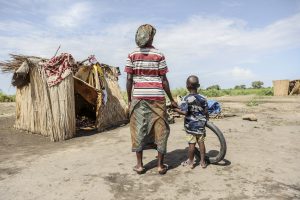Scroll down to learn about the challenge
In many conflict-affected countries throughout the world, parties to conflict are committing systematic attacks on hospitals and health care, with devastating impacts for children and other civilians. A report released in May 2021 by the Safeguarding Health in Conflict Coalition documented 806 incidents of violence against or obstruction of health care in 43 countries and territories in ongoing wars and violent conflicts in 2020, ranging from the bombing of hospitals in Yemen to the abduction of doctors in Nigeria. In his most recent annual report on children and armed conflict, the UN Secretary-General reports over 300 attacks on hospitals and health care in 2020 in a wide range of countries, including Afghanistan, the Democratic Republic of Congo, Libya, and Syria.
In these and many other countries, parties to conflict have bombed, looted, occupied, and temporarily or permanently closed hundreds of health facilities; shot at and stolen ambulances; threatened or forcibly detained health care workers; and denied passage at checkpoints to persons either attempting to reach hospitals to receive lifesaving treatment or deliver essential medicines and supplies. Attacks on health care compound challenges to children’s health, already exacerbated by weeks, months, and in some cases years of armed conflict. The situation has further worsened since 2020, as health systems struggle to respond to the COVID-19 pandemic.
Scroll down to learn about our approach
In 2017 and 2018, Watchlist published a series of reports (“Field Monitors”) thematically focused on attacks on hospitals and health care and the impact of these attacks on children in situations of armed conflict. This series of reports examining incidents and impacts of attacks, together with advocacy by Watchlist and its partners, contributed to efforts to prevent attacks, protect health workers, respond to attacks when they occur, and hold perpetrators to account.
Afghanistan
Ongoing conflict in Afghanistan and increased targeting of health care workers and facilities by parties to the conflict has further eroded Afghanistan’s already fragile health care system. Health care facilities have closed, medical personnel have fled, and as a result, thousands of civilians, primarily women and children, have lacked access to medical care. Both war-wounded persons and those requiring routine care have had to travel increasingly long distances, often on insecure roads, to access basic and specialized health care. Delays in treatment have resulted in further complications to injuries or illnesses.
Yemen
Years of continued conflict and direct targeting of health care facilities by parties to the conflict have led to the near total collapse of Yemen’s health care system. Hundreds of health care facilities have been bombed, resulting in partial or complete closure; thousands of medical personnel have fled; and tens of thousands of civilians, primarily women and children, have had little to no access to lifesaving medical care. As a result of fuel shortages, generators that are utilized to provide electricity to most hospitals have, in many cases, not been able to run. Without electricity, vaccinations requiring refrigeration have been ruined, ventilators for newborns have stopped functioning, and physicians have had to perform surgery on war-wounded patients by flashlight.
South Sudan
The civil war in South Sudan and the targeting of medical facilities and personnel and denial of humanitarian access by parties to the conflict led to the near collapse of the country’s nascent health care system. Parties to the conflict have looted health care facilities, resulting in partial or complete closure; detained or abducted health or humanitarian workers; and routinely prevented humanitarian organizations from accessing civilian populations. Lack of access to health and humanitarian aid, despite skyrocketing needs, has resulted in widespread outbreaks of public health epidemics, including famine and cholera.

